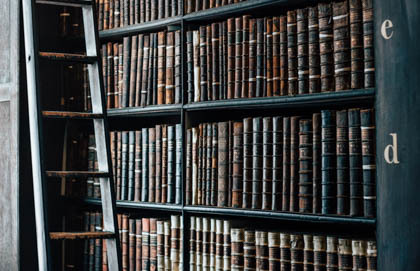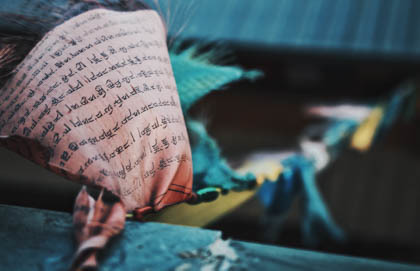A good historian, it's been said, is a creature with the power to resurrect the dead—an uncommon and altogether unnerving alchemy. He dusts them off, polite and reverent as only a historian can be, pulls together a respectable table and starts a good conversation. Guy Gavriel Kay is not a historian. Not even a bad one. He writes that most redoubtable of genres—fantasy, as in his Fionavar Tapestry, and now something like historical fiction with, as he puts it, a quarter-turn to the fantastic. His latest novel, River of Stars, was launched in April this year, received wide acclaim, and shot to the top of the best-seller charts. But Kay lives in no fear of being drafted into the ranks of academic historians. Despite, or maybe because of, this, he has accomplished the ends of history in an enviable, subtle and altogether beautiful way: he has fashioned icons of his books, a voice for the living faith of the dead.
One of the most celebrated historians, Jaroslav Pelikan, says an authentic image, an icon, is what it represents. Nevertheless, he adds, "[I]t bids us look at it, but through it and beyond it, to that living reality of which it is an embodiment." Ours is a singularly unnostalgic age, characterized by what Charles Taylor calls a "pitiless ingratitude to the past" that prizes literalism and fact over allusion, representation and embodiment. Icons such as Kay's novels are hard to understand in the secular age, but for the same reason they fascinate and capture for us the fullness of mystery, of a past that is not even the past, as William Faulkner says, that they press us into.
They are not literal, nor are they historical in the modern sense of the term. Despite this, Kay does an enormous amount of research for his novels, grounding them in the social imaginaries of people and times in history. His research is careful, and at times so accurate that segments of his novels will appear to the initiated as outright summations, or as quotes from accounts of record. In Sailing to Sarantium and Lord of Emperors, the two-novel story of Justinian and Theodora, the building of Hagia Sophia, the wars between blues and greens, the empire after the empire, the reader can be forgiven for flipping to Procopius' Secret History, for wondering even during some of the naughtier scenes if this wasn't just how Procopius put it.
His novels range, therefore, from those that are more inspired from a period, such as Tigana from Renaissance Italy, to those that seem more strictly historical, even down to parallels in characters themselves, such as Lin Shan of Katai in River of Stars. Consistently, however, whether more or less strict with the record, Kay makes good on his borrowed tag: a quarter-turn to the fantastic. He says, "This quarter-turn to the fantastic is underpinned by respect for the actual periods and the actual people that I'm using as the inspiration of my novels."
There lies the starting point. But by pursuing fiction, Kay engages in a little historiographical mischief. He creates space and distance between the "real" world of, say, 6th century Byzantium and the Sarantine Empire so that the reader understands, has an awareness, that this is not the "real" thing. In this, he makes the work of history more art than science. Kay challenges the brash tyranny of modern fact-finding, telling stories that get the facts wrong, that unabashedly make it up, and yet yield remarkable, felicitous truths. So often, he said recently in Toronto, people look at a representation and confuse it with the fullness of the thing itself, when instead it should push us onward toward a deeper, fuller reality that waits. We confuse the image, the foretaste, for the fullness. Idol is the name Jaroslav Pelikan gives for that mistake.
Kay blurs the lines of history and fiction, and in so doing brings to life more history than you might expect. The research he does provides an intellectual framework for the social imagination of a people and time, and the fictionalization of that imagination, the empathy of living inside another heart, another world, resists the easy, anachronistic analysis of a modern world. Motivations that people at the time took seriously must also be taken seriously, whether they were things the modern day might overlook, scoff at or simply ignore. The effect, for example, of context, lineage and history, the place of persons in a story, is Kay's most powerful, recurring theme. His latest release, River of Stars, reverberates against the backdrop of the once mighty Katai Empire, which has fallen into disarray, its Fourteen Prefectures held ransom by northern barbarians, its once glorious imperial capital, Xinan, in ruins. Yet it endures, still wealthy, still powerful, but crippled almost beyond the pale of what was once the great imperial Katai. Ghosts haunt its pages and its people, who live under the shadow that theirs is a smaller, diminished age.
Our modern age is remarkable not merely for its secularity and lack of nostalgia but also for its premise of progress. There is no sense in which those persons, periods or empires that preceded ours were in any measurable way superior to us. Where there is loss, it is qualified by the advances that were made along the way: pollution following industrial revolution, terrible total war on the back of breathtaking technological advancement. What must it be like to live in the ruins of a civilization so obviously superior to one's own? What would it be like to live in the slums and hovels of once mighty Coliseums? Inverting the story of progress challenges our implicit hubris. "Maturity in our relation to our parents," writes Pelikan, "consists in going beyond both a belief in their omniscience and a disdain for their weakness."
No historical fictionalization could hope to be period perfect, though. The constitutive values of modernity and of postmodernity in its various chameleon forms are not absent in Kay's writing. There are those, for example, who will find Kay's caricature of Byzantine Christianity to be distasteful, his frank and at times armchair theological commentary on the nature of the divinity of the Son to be somewhat of an indulgence. Kay's opinions are not so subtle as one might hope or as he might assert, saying in one interview: "I like to slip a stiletto into your ribs."
There is some progression in Kay's religious historical accounts, from the proto-religious mythology of Fionavar, with its deliberate elements of the fantastical and the magical, to Tigana, in which magic serves more as metaphor and memory, and finally to A Song for Arbonne, about how organized religion, the clergy, manipulates people. His novels move from high fantasy and world building to historical fiction with a quarter-turn from mythology to the religious. What is curious about his latest novels, such as Under Heaven and River of Stars, is that the quarter-turn is less fantasy and more history. Shamans shape-shift, spiritualists cast out demons, ghosts linger for resolution; all perfectly natural, all perfectly integrated, as it once was. That we call this fantasy says more, in many ways, about us than it does about our parents.
It is true, naturally, as Kay himself says, that to do justice to a period and its social imagination is to be deep in the work and life of the religious. Anything that ignores that is naked ideology, anachronism that privileges modern sensibilities over the stated accounts of persons of the time. In Toronto he said recently, "I hate historical fiction that panders completely to our modern sensibility and mindset." He tries not to "cheat," he adds, when working in a historical period. There is a special place in the library of Hell for novels that hammer you with the author's thesis.
Yet theses do emerge. In writing TheLionsof Al-Rassan, a lament for Moorish Spain and the clash that defined Iberia and the boundaries of what would be called Europe, Kay was interested to look at the context of organized religion, while stripped of its normative baggage. In an interview in 1995, Kay said:
"In The Lions of Al-Rassan, one of the reasons the book is a fantasy rather than a story about medieval Spain, even though it's very closely modelled on real history, is that I wanted to see what would happen to people's preconceptionsand prejudices about cultures, Christian, Moslem, Jewish, if the names were changed and if the religious beliefs were rendered virtually banal: one religion worships the Sun, another worships the Moon, and another worships the stars. And out of that relatively banal conflict of ideologies, you have crushingly brutal military and psychological conflict. When you speak of skepticism, it seems to me that The Lions of Al-Rassan should be very clear for the readers: the point that underlies the detaching of these religious conflicts from their real underpinnings is that, if we step back a bit, we can start to see how much violence, how much conflict is generated by something that may be no more complex than whether you worship the Sun rising in the morning or the stars beginning to shine at night."
The conversation and tension between some of the world's oldest and largest religions cannot, probably, be usefully understood apart from the serious religious and theological content of the faith. If belief renders practice, it is true also that practice carries and makes belief possible. In the same interview Kay said, "By the time we get to The Lions of Al-Rassan, it's mainly about how organized religion takes away the freedom and the breathing space of individuals." Not much of a stiletto. Few things could be more fashionably modern than for a man who claims no special religious affiliation for himself to overwork the tired pathologies of organized religion in the pre-modern world for parallel political points.
The truth of modern sensibilities is that they are not a pair of pants one puts on, or not, in the morning. In a communitarian invocation that Kay might appreciate, Alasdair MacIntyre writes, "[W]e are never more, often less, than the half-authors of our own stories." It is hard to imagine, for example, a contemporary, empathetic fiction of the zeal of Phineas in the Hebrew Scriptures, proudly murdering Israelites for ethnic commingling with Moabites, later recalled and praised in the Psalms. Arguably, modern sensibilities will fundamentally underpin even the most ambitious historical fiction, or fact for that matter, partly because we can imagine it no other way and partly because even if we could, it would be repulsive to us.
Yet for all the accidents and inevitabilities of modern sensibilities, Kay's work is both unique and celebrated for the integrity he shows the historical record, bringing to life faiths and worlds long dead, long passed from mind and imagination. His sensibilities have at times lacked subtlety, but the longer he writes, the less postmodern polemic weaves through his fantasy and the more his novels serve as iconography, pointing beyond the thing to a greater fullness, a kind of neighbour-love extended across space and time in an exercise of fictional empathy. Cardinal Newman once said that to be deep in history is to cease to be Protestant. With a little charity, let us say that to be deep in history may simply be to cease to be modern. Guy Gavriel Kay is neck deep in history: the deeper he gets, the less the spiritual and the religious look like fantasy and the more they look like what used to be called, for most of our long-forgotten parents, reality. As it turns out, a quarter-turn to the fantastic may be just what the modern reader needs to exorcise the demons of hubris and progress, and breathe into us—again—the living faith of the dead.






